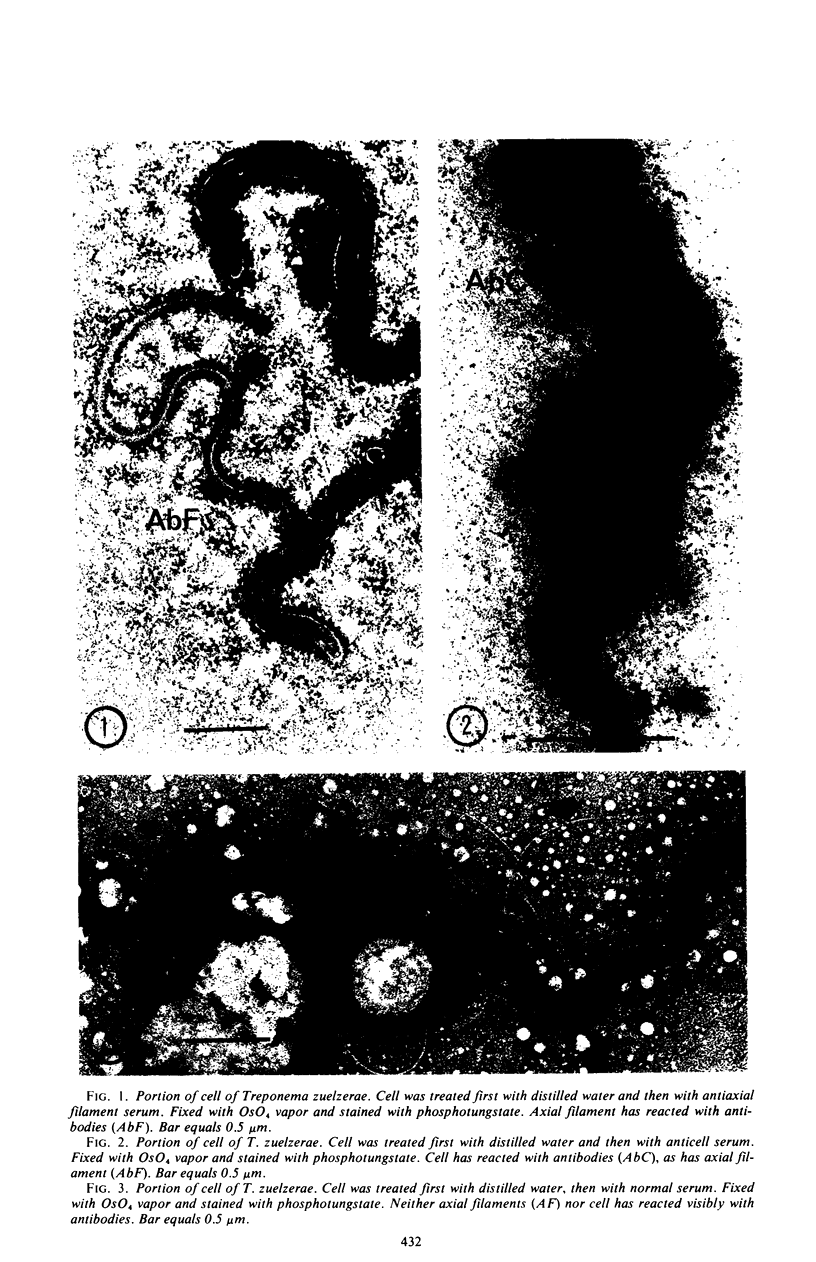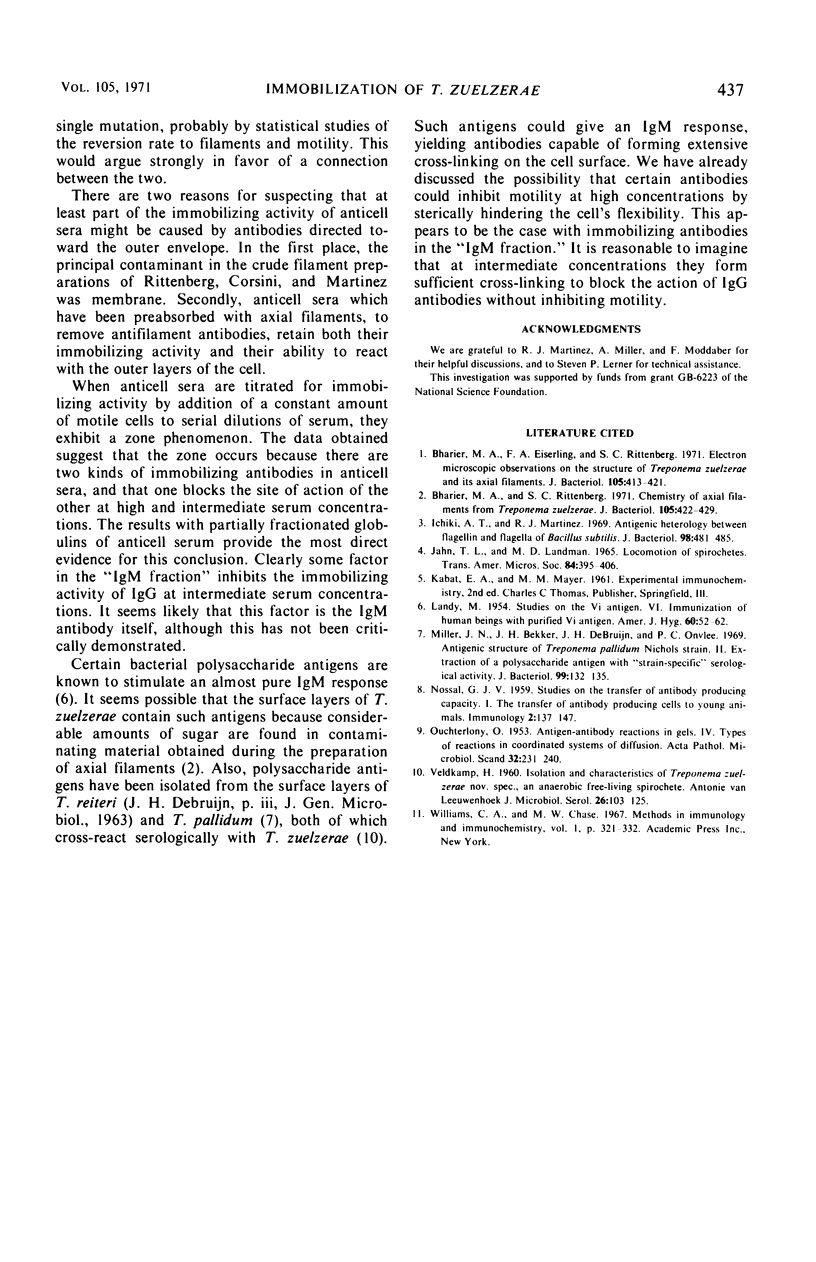Abstract
Rabbit antisera were produced against whole cells and against highly purified axial filaments of Treponema zuelzerae. Both types of sera react with axial filaments. Antisera against whole cells immobilize the organism; antisera against axial filaments do not. The immobilizing activity of anticell sera could be neutralized by preabsorption with whole cells but not by preabsorption with axial filaments. Preabsorption with axial filaments did, however, abolish the ability of anticell sera to react with axial filaments. Anticell sera also react with the outer cell envelope; this ability was not affected by preabsorption with axial filaments. The data show that antibody directed at something other than axial filaments causes immobilization of T. zuelzerae. The results do not exclude the possibility that the axial filament is the organelle of motility. Titration of the immobilizing activity of anticell sera by adding a constant amount of motile cells to serial dilutions of serum gave two zones of maximum immobilization, one with undiluted serum and one at higher dilutions. For a fixed amount of antiserum, increasing the numbers of cells in the titration almost, but not quite, abolished the zone phenomenon. This phenomenon appears to result from the presence of two kinds of immobilizing antibodies in anticell serum. One of these belongs to the IgG class of immunoglobulins. The other has not been identified but is present in a serum globulin fraction which contains IgM. At intermediate concentrations, the “IgM fraction” inhibits the immobilizing activity of IgG without itself causing immobilization.
Full text
PDF







Images in this article
Selected References
These references are in PubMed. This may not be the complete list of references from this article.
- Bharier M. A., Eiserling F. A., Rittenberg S. C. Eletron microscopic observations on the structure of Treponema zuelzerae and its axial filaments. J Bacteriol. 1971 Jan;105(1):413–421. doi: 10.1128/jb.105.1.413-421.1971. [DOI] [PMC free article] [PubMed] [Google Scholar]
- Bharier M. A., Rittenberg S. C. Chemistry of axial filaments of Treponema zuezerae. J Bacteriol. 1971 Jan;105(1):422–429. doi: 10.1128/jb.105.1.422-429.1971. [DOI] [PMC free article] [PubMed] [Google Scholar]
- Ichiki A. T., Martinez R. J. Antigenic heterology between flagellin and flagella of Bacillus subtilis. J Bacteriol. 1969 May;98(2):481–485. doi: 10.1128/jb.98.2.481-485.1969. [DOI] [PMC free article] [PubMed] [Google Scholar]
- JAHN T. L., LANDMAN M. D. LOCOMOTION OF SPIROCHETES. Trans Am Microsc Soc. 1965 Jul;84:395–406. [PubMed] [Google Scholar]
- LANDY M. Studies on Vi antigen. VI. Immunization of human beings with purified Vi antigen. Am J Hyg. 1954 Jul;60(1):52–62. doi: 10.1093/oxfordjournals.aje.a119703. [DOI] [PubMed] [Google Scholar]
- Miller J. N., Bekker J. H., DeBruijn J. H., Onvlee P. C. Antigenic structure of Treponema pallidum, Nichols strain. II. Extraction of a polysaccharide antigen with "strain-specific" serological activity. J Bacteriol. 1969 Jul;99(1):132–135. doi: 10.1128/jb.99.1.132-135.1969. [DOI] [PMC free article] [PubMed] [Google Scholar]
- NOSSAL G. J. Studies on the transfer of antibody-producing capacity. I. The transfer of antibody-producing cells to young animals. Immunology. 1959 Apr;2(2):137–147. [PMC free article] [PubMed] [Google Scholar]
- OUCHTERLONY O. Antigen-antibody reactions in gels. IV. Types of reactions in coordinated systems of diffusion. Acta Pathol Microbiol Scand. 1953;32(2):230–240. [PubMed] [Google Scholar]
- VELDKAMP H. Isolation and characteristics of Treponema zuelzerae nov. spec., and anaerobic, free-living spirochete. Antonie Van Leeuwenhoek. 1960;26:103–125. doi: 10.1007/BF02538999. [DOI] [PubMed] [Google Scholar]




